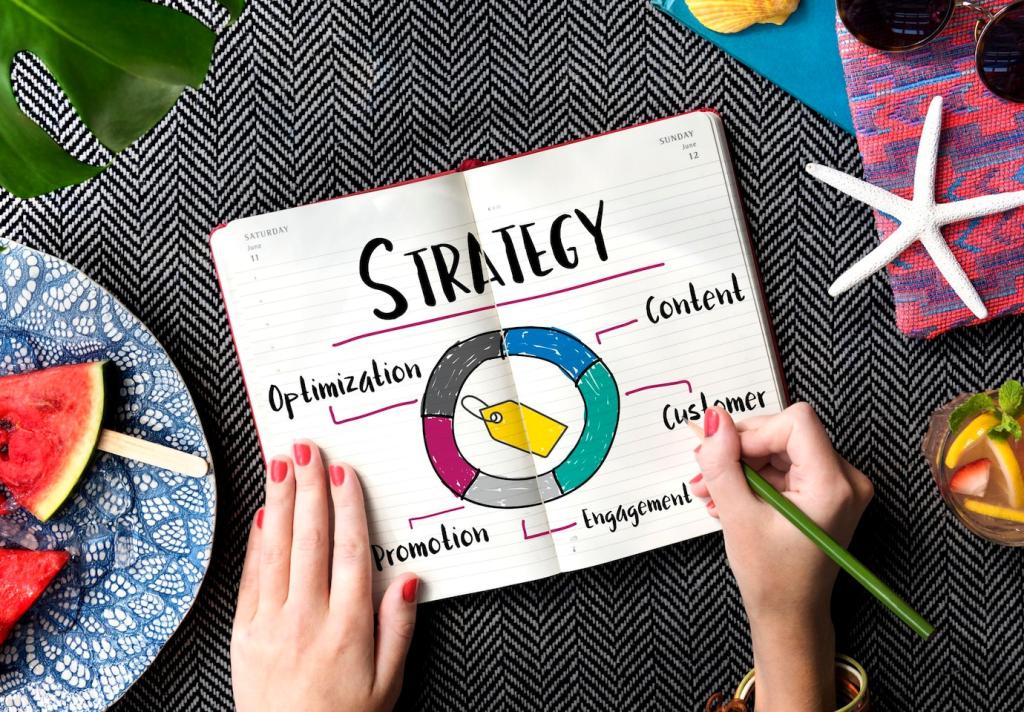
Your Effective Marketing Strategy Blueprint Starts Today
Chosen theme: Effective Marketing Strategy Blueprint. Welcome to a practical, energizing guide that turns big-picture ambition into a clear plan you can execute, measure, and continuously improve. Stay with us, share your insights, and subscribe for the next blueprint chapter.

Define Bold Objectives and Crystal-Clear KPIs
Choose a single, unifying outcome that clarifies priorities and prevents shiny-object drift. Whether it is qualified pipeline, trials, or repeat purchases, make it visible across teams and ask everyone to explain how their work moves the needle.
Define Bold Objectives and Crystal-Clear KPIs
Turn broad aspirations into specific, measurable, achievable, relevant, time-bound targets. For example, commit to increasing qualified demos by a defined percentage within a quarter by focusing on mid-funnel content and high-intent channels your blueprint identifies.
Interview customers and lost prospects to understand what progress they seek, why they switch, and what blocks their success. Turn findings into scenario-based personas that inform messaging, offers, and channels across every stage of your blueprint.
Know Your Audience Better Than Your Competitors Do
Document the steps buyers actually take, including peer recommendations, review checks, procurement hurdles, and internal politics. Highlight emotional moments where reassurance matters, and operational moments where speed, clarity, or proof unlocks forward movement.
Know Your Audience Better Than Your Competitors Do



Channel Mix and Full-Funnel Architecture
Prioritize channels where your message, budget, and buyer intent align. Blend demand creation with demand capture, and give each channel a clear job to do so you can evaluate performance honestly.
Channel Mix and Full-Funnel Architecture
Pair ads with landing experiences that mirror the promise, remove unnecessary fields, and lead to meaningful next steps. Offer value exchanges like calculators, trials, or audits that naturally qualify interest within your blueprint.
Content Blueprint and Editorial Rhythm
Define three to five content pillars aligned to your audience’s jobs-to-be-done. Create flagship pieces, then repurpose into playbooks, clips, carousels, and enablement assets, ensuring every derivative points back to your core blueprint message.


Forecast ranges tied to assumptions like conversion rates, sales cycle length, and average order value. Document risks and leading indicators so you can adjust earlier, not later, as reality informs your blueprint.

Start small, prove channel-message fit, then scale. Protect exploration budget for controlled experiments while maintaining a core allocation for dependable performers. This balance keeps growth and learning alive inside your strategy.

Map skills to the blueprint’s requirements: strategy, creative, data, operations, and enablement. Fill gaps with training, contractors, or partnerships. Comment with one capability you plan to strengthen this quarter and subscribe for our skills matrix template.
Execution Playbooks and Cross-Functional Alignment
Write Clear Playbooks People Actually Use
For each campaign, document objectives, target, message, assets, timeline, owners, and definitions of done. Keep them short, visual, and searchable so teams can move quickly without losing alignment.
Revenue Team Rituals That Matter
Hold weekly standups for pipeline health, monthly retros for learning, and quarterly planning to reset priorities. Share call snippets and win-loss insights so messaging and offers evolve with the market, not after it.
A Story of Alignment in Action
A mid-market SaaS team invited customer success to co-create onboarding content. Churn dropped, referrals rose, and sales used the same assets to close faster. Share one partner you will bring into your next campaign.

Define Few Metrics, Review Often
Choose leading indicators that predict your lagging outcomes, and meet regularly to interpret changes. Visualize trends, not only snapshots, so you see trajectory and seasonality before committing big shifts.
Design Clean Experiments
Test one variable at a time, size your samples, and predefine success thresholds. Share results publicly with your team to build a culture where learning is celebrated and decisions feel grounded, not impulsive.
Close the Loop with Action
Archive findings in a living knowledge base, roll out winners across channels, and retire underperformers without drama. Comment with an experiment you are excited to run, and subscribe for our monthly experiment prompts aligned to this blueprint.
